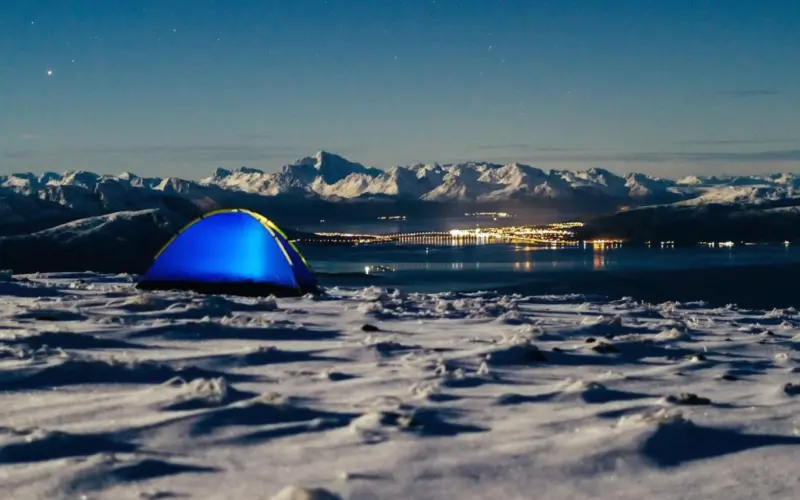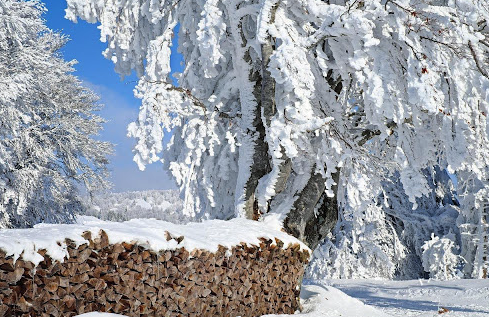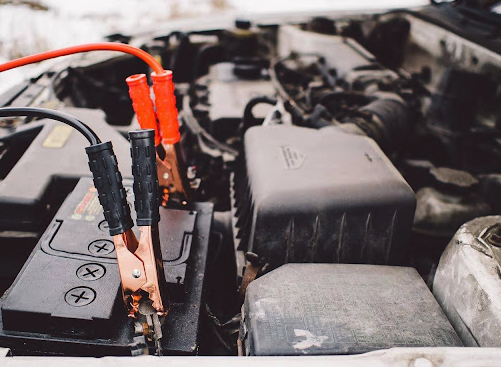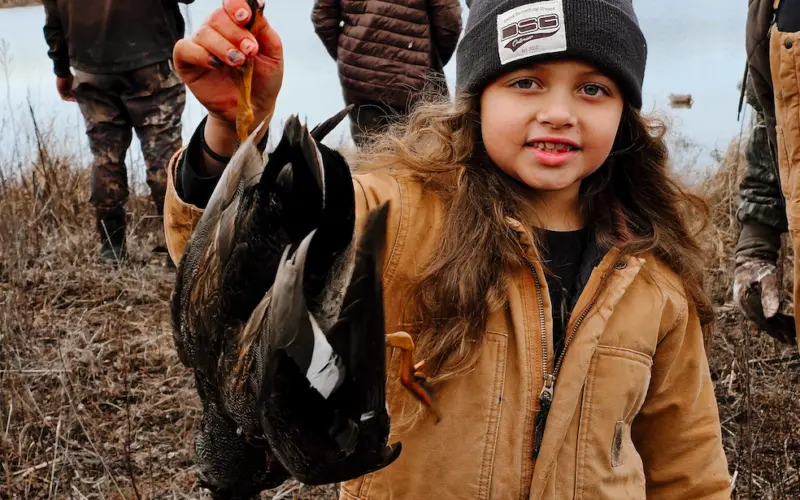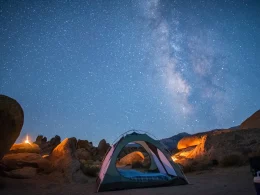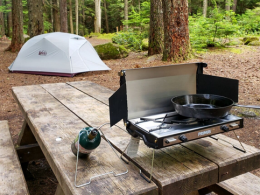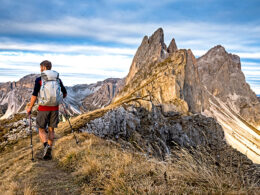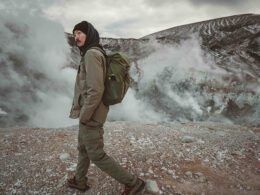Over the past three years, I’ve embraced the adventurous, albeit challenging, lifestyle of living outdoors through winter’s harsh conditions. Swapping the comfort of a warm house for the unpredictable and often unforgiving nature of winter camping, I’ve learned not just to survive, but to thrive in the cold.
This unusual choice stems from a deep passion for nature and a quest for simplicity. Winter’s outdoor living brings unique challenges, including battling the cold, mastering survival skills, and finding warmth in solitude. It also offers unparalleled rewards: serene sunrises, heightened self-reliance, and a profound peace of mind.
In this article, I’ll share five key lessons learned from my frosty adventures in the hopes that you avoid having to learn these things the hard way, as I did.
Table of Contents
1. The Importance of Layering Beneath You While Sleeping
One of the most crucial lessons I’ve learned while living outdoors in winter is the significance of having multiple layers beneath you while sleeping. This seemingly simple strategy can be the difference between a restful night and a shivering ordeal.
Understanding the Ground’s Impact
The ground acts like a sponge for heat, drawing it away from your body rapidly if you’re not properly insulated. You may warm at first with your sleeping bag, but with it compressed underneath you the chill will be present and it’s only a matter of time before you start shivering. This effect intensifies in winter, making it imperative to have a barrier against this heat loss to stay warm.
Closed Cell Foam and Insulated Air Mats
Closed-cell foam mats and insulated air mats are my go-to’s for winter camping. Closed cell foam provides a durable, insulating layer that’s impervious to moisture – essential for snowy conditions so you don’t wake up in a puddle.
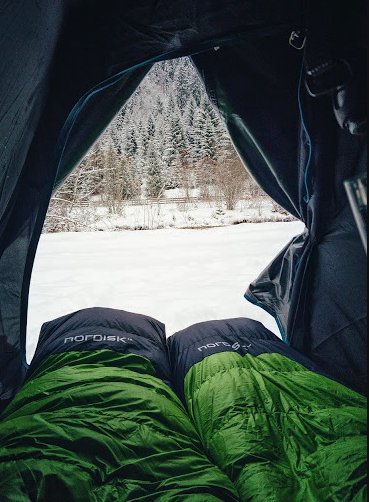
Insulated air mats, though more expensive, offer the best comfort and warmth by creating a thicker barrier of air between you and the ground. Combine this with a closed-cell foam mat and you should be good for some really cold nights.
The Cot Conundrum
One might assume that sleeping on a cot, elevated above the ground, negates the need for insulation. This, however, is a misconception. Air circulating beneath the cot can significantly cool it down, making an insulated mat just as crucial as it would be sleeping directly on the ground.
Think of it like a hammock, as the air passes underneath you the heat is stolen from your body. Having a couple of foam mats under your body while you sleep is pretty effective. Lay a wool blanket down on the mat for extra insulation.
2. Firewood Fundamentals: Always Double Up
Securing the right amount, and type of firewood, can make the difference between a cozy night and a cold, miserable experience. For me, it is my favorite time of the day, chopping firewood. It can become difficult, though, if you’re not used to it. I would suggest taking it slow at first so you don’t wear your body out by the next day. While our bodies can fail, the weather stays steady, you should always be in good enough condition to chop wood.
Estimating Your Needs
The biggest mistake I made earlier on was underestimating the amount of firewood I would need. A reliable rule of thumb is to gather or bring what you think will be enough, and then double it. If you anticipate particularly cold temperatures, tripling your initial estimate is wise. Over time, you’ll develop a more accurate sense of how much you’ll actually use, but it’s always better to have too much than too little. On average, for constant warmth throughout the night in a camping wood stove, you might burn through a small bundle (about an armful) every 1-2 hours.
The Best Wood Types
Initiate your fire with a softwood like pine for quick ignition. Once the fire is robust, switch to hardwoods such as oak or maple. Hardwoods not only generate more heat but also burn longer and cleaner, reducing creosote buildup in your stove or fireplace, a common issue that can lead to dangerous chimney fires.
Practical Tips for Storing Wood in the Tent
Storing your firewood inside your tent not only keeps it dry but slightly pre-warms it, ensuring it ignites more readily. Keep the wood near the entrance to avoid moisture buildup throughout your sleeping area. Utilize a small canvas tarp underneath to catch any debris and have a small broom handy for regular cleanups. This practice not only helps keep your campsite tidy but also reduces the likelihood of getting your clothes dirty.
3. Battery Life in the Cold
When venturing into cold environments, understanding how the cold affects battery life is essential for keeping your devices powered. Whether you’re relying on a smartphone for GPS navigation, a portable stove, or lighting, the cold can significantly impede its effectiveness by reducing battery life. I’ve had my fair share of battery issues in the cold, but I have figured out some tips to help you manage.
Your Car Battery
In cold climates, the practice of starting my truck daily, and occasionally twice a day if the temperatures drop significantly, becomes important. I don’t have a block heater when I’m out in the woods so there are other things I have to do to keep the battery going.
After about four days of leaving the truck idle in the cold, initiating the engine becomes a challenge. It’s as if the cold seeps into the battery, affecting its ability to hold and deliver a charge. I always keep a car battery charger in the back that I can hook up to my battery to give it some juice.
Alternatively, I will shovel hot coals from the stove under the truck in an attempt to heat the battery and engine block. But be careful not to have the coals too hot.
Keeping Your Power Sources Warm
To minimize the impact of cold on batteries, I keep them as warm as possible. For instance, I will sleep with sensitive electronics (my phone for example). I will also keep them in my pockets so that they don’t stay too cold for too long.
If the batteries are cold then they will discharge much faster than normal. It will also hinder how fast they charge. Believe it or not, the cold can affect the quality of a charge too, potentially causing an issue with your device.
Solar Panel Limitations in Freezing Temperatures
Portable solar panels are less efficient in cold, cloudy climates, primarily due to reduced sunlight. These are not the ones that are attached to your house, but the panels that are available for battery generators. I’ve learned it’s important to adjust your expectations and plan for lower power generation. If you’re able to keep the panel in full sunlight then it will most likely stay warm in colder temperatures.
4. Wear the Right Clothing
More often than not, when braving the elements for extended periods, one finds themselves wearing the same clothing multiple days in a row. This makes it vital to choose attire that is not only suitable for the climate you’re in but also capable of withstanding the rigors of outdoor living. Comfort, durability, and adaptability to changing weather conditions should be top priorities when packing your wilderness wardrobe.
Choosing Your Wardrobe Wisely
The secret to keeping cozy and snug outside is all about picking the right gear and layering like a pro. You’ll want tough, warm fabrics that can handle any weather. Thin layers help trap heat easier and can be shed at a moment’s notice. I like to wear several thin layers topped with a thicker layer (like a heavy jacket or wool sweater.) to help keep me warm.
And let me tell you, a buff is a must-have! It helps keep in the warmth by shielding and insulating what I like to call the “neck vents,” where a surprising amount of heat sneaks out.
Managing Sweat and Dirt
Maintaining hygiene and warmth in cold environments requires a strategic approach to managing sweat and dirt. Sometimes, as embarrassing as it may be, a sponge bath becomes necessary to remove dirt and sweat, improving your mood and reducing the risk of skin irritations. Another thing I learned is to avoid sweating as much as possible; when that wind blows it can take the heat right from you.
5. Nutrition: Fueling the Winter Outdoor Lifestyle
In the demanding conditions of winter outdoors, nutrition takes on a pivotal role. Opting for calorie-dense foods becomes essential for maintaining energy levels and body warmth.

Here is a short list of things I like to have on hand when I’m out in the winter:
- Meats like beef, bison, and venison are not only rich in the vital protein and fats needed for sustenance but also help in heat generation.
- Chocolate, apart from being a delightful treat, can significantly uplift one’s mood, acting as a quick source of both energy and a positive mindset. I always strive to carry some candy and chocolate with me at all times for those moments.
- The significance of hot beverages, such as coffee, cannot be overstated—they are crucial for warming the body and soul.
It’s crucial to keep meals simple to avoid any digestive discomforts—diarrhea in winter is exceptionally inconvenient. Comfort food, in its simplicity, does wonders in keeping you content and warm.
Conclusion
In my experience, enduring the winter outdoors teaches a lot of invaluable lessons. The biggest lesson is how to change your outlook to adapt to nature, not the other way around. This means overcoming a lot of physical weaknesses and going out to chop wood. It also means learning to be comfortable with yourself as the wildlife and nature in general are still asleep, leaving you feeling quite alone.
Each lesson contributes to a more comfortable, enjoyable experience. I encourage everyone to embrace winter camping, armed with these insights, to discover the serene beauty and unique challenges it presents. Reflecting on my adventures, I find that braving the cold not only tests one’s resilience but also unveils the profound tranquility of living through winter outdoors.

